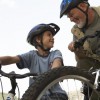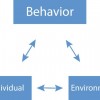 American families have changed dramatically over the last century. Currently, about half the children in the United States will live apart from their fathers some time during their childhood because their parents have separated and the proportion of births to unmarried women has risen from 5 percent in 1960 to 41 percent in 2011. But a father who is absent from the household may not necessarily be absent from his child’s life. This 5-page fact sheet provides a brief summary of the history of fatherhood in America and discusses the importance of involved fathers, and how mothers, other family members, and adult role models can make a positive impact in a child’s life. Written by Sarah M. Ellis, Yasmin S. Khan, Victor W. Harris, Ricki McWilliams, and Diana Converse, and published by the UF Department of Family Youth and Community Sciences, October 2014.
American families have changed dramatically over the last century. Currently, about half the children in the United States will live apart from their fathers some time during their childhood because their parents have separated and the proportion of births to unmarried women has risen from 5 percent in 1960 to 41 percent in 2011. But a father who is absent from the household may not necessarily be absent from his child’s life. This 5-page fact sheet provides a brief summary of the history of fatherhood in America and discusses the importance of involved fathers, and how mothers, other family members, and adult role models can make a positive impact in a child’s life. Written by Sarah M. Ellis, Yasmin S. Khan, Victor W. Harris, Ricki McWilliams, and Diana Converse, and published by the UF Department of Family Youth and Community Sciences, October 2014.
http://edis.ifas.ufl.edu/fy1451
Category: Children
Bullying Related to Lack of Time with Dad
 It’s a bad feeling for any parent: the sinking realization that your child has been teasing or even harming other children. No one wants to be the parent of a bully. Yet many are, given that more than a third of children in grades K through 8 report being bullied. This 2-page Family Album Radio transcript was written by Carol Church, and published by the UF Department of Family Youth and Community Sciences, August 2014.
It’s a bad feeling for any parent: the sinking realization that your child has been teasing or even harming other children. No one wants to be the parent of a bully. Yet many are, given that more than a third of children in grades K through 8 report being bullied. This 2-page Family Album Radio transcript was written by Carol Church, and published by the UF Department of Family Youth and Community Sciences, August 2014.
http://edis.ifas.ufl.edu/fm1143
Los ninos y los pesticidas
 Los niños actúan rápido, pero también lo hacen los venenos, incluidos los pesticidas. Afortunadamente para la mayoría de los padres, sus hijos no son perjudicados cuando los padres tienen un lapso momentáneo y no los supervisan por un corto tiempo. Pero ¿cómo responderían los padres si de repente se dan la vuelta, y su niño está sosteniendo una lata de aerosol con insecticida para el hogar? Esta publicación describe algunos hechos y medidas de precaución con respecto a los niños y los pesticidas en el ambiente del hogar, para que los padres tengan una mejor idea de cómo mantener productos químicos dañinos lejos de sus hijos.
Los niños actúan rápido, pero también lo hacen los venenos, incluidos los pesticidas. Afortunadamente para la mayoría de los padres, sus hijos no son perjudicados cuando los padres tienen un lapso momentáneo y no los supervisan por un corto tiempo. Pero ¿cómo responderían los padres si de repente se dan la vuelta, y su niño está sosteniendo una lata de aerosol con insecticida para el hogar? Esta publicación describe algunos hechos y medidas de precaución con respecto a los niños y los pesticidas en el ambiente del hogar, para que los padres tengan una mejor idea de cómo mantener productos químicos dañinos lejos de sus hijos.
This 3-page fact sheet is a Spanish-language translation of Children and Pesticides, written by Frederick M. Fishel and Tatiana Sánchez, and published by the UF Department of Agronomy, March 2014.
http://edis.ifas.ufl.edu/pi250
Raising Healthy Children: Age Four
 As children continue their preschool years, they learn many new things and develop their own opinions and ideas. During this time, people inside and outside of the home may greatly influence them. As preschoolers continue to learn and grow, caregivers can take many steps to guide their children in a healthy and positive direction. This 4-page fact sheet was written by Kate Bennet, Gail Kauwell, and Karla P. Shelnutt, and published by the UF Department of Family Youth and Community Sciences, April 2014.
As children continue their preschool years, they learn many new things and develop their own opinions and ideas. During this time, people inside and outside of the home may greatly influence them. As preschoolers continue to learn and grow, caregivers can take many steps to guide their children in a healthy and positive direction. This 4-page fact sheet was written by Kate Bennet, Gail Kauwell, and Karla P. Shelnutt, and published by the UF Department of Family Youth and Community Sciences, April 2014.
http://edis.ifas.ufl.edu/fy1398
Understanding the New School Meal Standards
 If you have school-age children, you may have heard that the 2012 school year brought major changes to the meals children eat at school. All meals provided through the School Breakfast and National School Lunch Programs now must be consistent with the USDA’s Dietary Guidelines for Americans. This 6-page fact sheet was written by Jenna Norris, Karla P. Shelnutt, and Gail P. A. Kauwell, and published by the UF Department of Family Youth and Community Sciences, October 2013.
If you have school-age children, you may have heard that the 2012 school year brought major changes to the meals children eat at school. All meals provided through the School Breakfast and National School Lunch Programs now must be consistent with the USDA’s Dietary Guidelines for Americans. This 6-page fact sheet was written by Jenna Norris, Karla P. Shelnutt, and Gail P. A. Kauwell, and published by the UF Department of Family Youth and Community Sciences, October 2013.
http://edis.ifas.ufl.edu/fy1396
Inclusion of Diverse Learners in the Educational System
 Every student in the United States has the right to an education. But not every student is ready, prepared, or willing to learn. Teachers trying to fully engage students in the learning environment can find it difficult when working with students from diverse backgrounds. Forms of diversity such as socioeconomic status, ethnicity/race, learning style, cognitive ability, gender, and ability to process and store knowledge can cause an “achievement gap” between students. This 4-page fact sheet highlights effective educational strategies for engaging students in the learning environment and assisting in closing achievement gaps. Written by Eric D. Rubenstein and Andrew C. Thoron, and published by the UF Department of Agricultural Education and Communication, July 2013.
Every student in the United States has the right to an education. But not every student is ready, prepared, or willing to learn. Teachers trying to fully engage students in the learning environment can find it difficult when working with students from diverse backgrounds. Forms of diversity such as socioeconomic status, ethnicity/race, learning style, cognitive ability, gender, and ability to process and store knowledge can cause an “achievement gap” between students. This 4-page fact sheet highlights effective educational strategies for engaging students in the learning environment and assisting in closing achievement gaps. Written by Eric D. Rubenstein and Andrew C. Thoron, and published by the UF Department of Agricultural Education and Communication, July 2013.
http://edis.ifas.ufl.edu/wc150
When the Kids Move Back Home
 Recent trends show that more and more adult children are returning to live with their parents. With intergenerational cohabitation on the rise, it’s a good idea to examine the “what-ifs” before the doorbell rings. If you find yourself making up spare rooms for your grown children or even their children, you will be glad you thought about the issues in advance. This publication discusses the potential challenges and practical matters you need to know about if your adult children move back home. This 4-page fact sheet was written by Lynda Spence and Larry Forthun, and published by the UF Department of Family Youth and Community Sciences, July 2013.
Recent trends show that more and more adult children are returning to live with their parents. With intergenerational cohabitation on the rise, it’s a good idea to examine the “what-ifs” before the doorbell rings. If you find yourself making up spare rooms for your grown children or even their children, you will be glad you thought about the issues in advance. This publication discusses the potential challenges and practical matters you need to know about if your adult children move back home. This 4-page fact sheet was written by Lynda Spence and Larry Forthun, and published by the UF Department of Family Youth and Community Sciences, July 2013.
http://edis.ifas.ufl.edu/fy1376
Love and Acceptance Are Crucial to Development Worldwide
 If you’ve ever traveled to another country, perhaps one far across the world, you may have been struck by the universal nature of the tender and sometimes tricky relationship between parent and child. Now a new analysis of 36 studies from 18 countries, published in the journal Personality and Social Psychology Review, confirms some important truths about how parents can affect their children for a lifetime. This 2-page Family Album Radio transcript was written by Carol Church, and published by the UF Department of Family Youth and Community Sciences, August 2013.
If you’ve ever traveled to another country, perhaps one far across the world, you may have been struck by the universal nature of the tender and sometimes tricky relationship between parent and child. Now a new analysis of 36 studies from 18 countries, published in the journal Personality and Social Psychology Review, confirms some important truths about how parents can affect their children for a lifetime. This 2-page Family Album Radio transcript was written by Carol Church, and published by the UF Department of Family Youth and Community Sciences, August 2013.
http://edis.ifas.ufl.edu/fm1135
Developmental Coordination Disorder (FAR1816/FM1076)
 In any classroom, you’ll find a wide range of physical skills. Some children are amazing artists but just average at kickball. Others excel at sports but struggle with handwriting. But a few children seem to have a hard time with most physical tasks. They may be affected by developmental coordination disorder, or DCD, a neurodevelopmental condition that causes difficulties with physical coordination. This 2-page Family Album Radio transcript was written by Carol Church, and published by the UF Department of Family Youth and Community Sciences, April 2013.
In any classroom, you’ll find a wide range of physical skills. Some children are amazing artists but just average at kickball. Others excel at sports but struggle with handwriting. But a few children seem to have a hard time with most physical tasks. They may be affected by developmental coordination disorder, or DCD, a neurodevelopmental condition that causes difficulties with physical coordination. This 2-page Family Album Radio transcript was written by Carol Church, and published by the UF Department of Family Youth and Community Sciences, April 2013.
http://edis.ifas.ufl.edu/fm1076
Kinship Caregivers: Understanding Children and the Military Deployment Cycle (FCS2330/FY1368)
 Deployment occurs in almost every branch of the military, and the experience differs for each family and each family member. To reflect the diversity of experiences, military professionals have proposed various models of the deployment cycle to assist families in the transition. There are at least five phases that are common across models: pre-deployment, deployment, sustainment, preparation (also known as redeployment), and reunification (or home-coming). Recognizing that each family is unique, this deployment cycle is intended not as a rule-book but as a helpful guide to families as they experience deployment of a parent. This 4-page fact sheet was written by Elizabeth Thomas and Larry F. Forthun, and published by the UF Department of Family Youth and Community Sciences, March 2013.
Deployment occurs in almost every branch of the military, and the experience differs for each family and each family member. To reflect the diversity of experiences, military professionals have proposed various models of the deployment cycle to assist families in the transition. There are at least five phases that are common across models: pre-deployment, deployment, sustainment, preparation (also known as redeployment), and reunification (or home-coming). Recognizing that each family is unique, this deployment cycle is intended not as a rule-book but as a helpful guide to families as they experience deployment of a parent. This 4-page fact sheet was written by Elizabeth Thomas and Larry F. Forthun, and published by the UF Department of Family Youth and Community Sciences, March 2013.
http://edis.ifas.ufl.edu/fy1368
Bottle-Feeding Your Baby (FCS80026/FY1359)
 Families choose to bottle-feed their babies for many reasons. While bottle-feeding is not difficult, you need to know several things to feed your baby safely and ensure that he or she receives the nutrition and bonding needed for proper growth and development. If you are considering bottle-feeding your baby or have decided that bottle-feeding is the best option for your situation, this publication will help you learn about bottle-feeding. This 5-page fact sheet was written by Sarah A. Schmidt, Karla P. Shelnutt, and Gail P. A. Kauwell, and published by the UF Department of Family Youth and Community Sciences, April 2013.
Families choose to bottle-feed their babies for many reasons. While bottle-feeding is not difficult, you need to know several things to feed your baby safely and ensure that he or she receives the nutrition and bonding needed for proper growth and development. If you are considering bottle-feeding your baby or have decided that bottle-feeding is the best option for your situation, this publication will help you learn about bottle-feeding. This 5-page fact sheet was written by Sarah A. Schmidt, Karla P. Shelnutt, and Gail P. A. Kauwell, and published by the UF Department of Family Youth and Community Sciences, April 2013.
http://edis.ifas.ufl.edu/fy1359
Kinship Caregivers: Communicating with Children about a Parent’s Deployment (FCS2329/FY1367)
 The deployment of a military parent is undoubtedly a difficult time for children. This is especially true if the military child is being cared for by a relative, or kinship parent such as a grandparent, aunt, uncle, or older sibling. The child may have to experience a kind of personal deployment from their own home. To help children cope with these changes, it is important for the kinship parent to effectively communicate with the child about the deployment and the deployed parent. This will safeguard against emotional and behavioral problems and can lead to improvements in the child’s overall sense of well-being. This 3-page fact sheet was written by Elizabeth Thomas and Larry F. Forthun, and published by the UF Department of Family Youth and Community Sciences, March 2013.
The deployment of a military parent is undoubtedly a difficult time for children. This is especially true if the military child is being cared for by a relative, or kinship parent such as a grandparent, aunt, uncle, or older sibling. The child may have to experience a kind of personal deployment from their own home. To help children cope with these changes, it is important for the kinship parent to effectively communicate with the child about the deployment and the deployed parent. This will safeguard against emotional and behavioral problems and can lead to improvements in the child’s overall sense of well-being. This 3-page fact sheet was written by Elizabeth Thomas and Larry F. Forthun, and published by the UF Department of Family Youth and Community Sciences, March 2013.
http://edis.ifas.ufl.edu/fy1367
My Child Has a Mental Illness: Developing Parental Advocacy Skills (FCS2327/FY1365)
 If your child is diagnosed with a mental illness, you will face major changes in your life. Being proactive about your child’s care and advocating for him or her will help you and your child handle the illness successfully. This 5-page fact sheet was written by Tracy DeCubellis, Victor W. Harris, and Martie Gillen, and published by the UF Department of Family Youth and Community Sciences, April 2013.
If your child is diagnosed with a mental illness, you will face major changes in your life. Being proactive about your child’s care and advocating for him or her will help you and your child handle the illness successfully. This 5-page fact sheet was written by Tracy DeCubellis, Victor W. Harris, and Martie Gillen, and published by the UF Department of Family Youth and Community Sciences, April 2013.
http://edis.ifas.ufl.edu/fy1365
Family Reunification Following Foster Care (FCS2328/FY1366)
 Families reuniting after an intervention that requires foster care for the children face unique challenges. Parents in these situations may need to learn about their parental roles, the basic needs for the healthy development of their children, and resources that will help the family in their reunification. Researchers and practitioners in child welfare have provided helpful information to develop workable plans to aid families in reunifying and rebuilding. This 5-page fact sheet is a brief summary of the overarching themes provided by the literature. Written by Rosalyn Monroe and Victor W. Harris, and published by the UF Department of Family Youth and Community Sciences, April 2013.
Families reuniting after an intervention that requires foster care for the children face unique challenges. Parents in these situations may need to learn about their parental roles, the basic needs for the healthy development of their children, and resources that will help the family in their reunification. Researchers and practitioners in child welfare have provided helpful information to develop workable plans to aid families in reunifying and rebuilding. This 5-page fact sheet is a brief summary of the overarching themes provided by the literature. Written by Rosalyn Monroe and Victor W. Harris, and published by the UF Department of Family Youth and Community Sciences, April 2013.
http://edis.ifas.ufl.edu/fy1366
Raising Healthy Children: Health Risks of Obesity (FCS80023/FY1356)
 Although babies need fat for warmth and normal growth, as children develop, too much fat can be unhealthy. Childhood obesity may result in health problems early in life and into adulthood. This 4-page fact sheet will help you understand the health risks of obesity and ways to help your child maintain a healthy weight. Written by Stephanie Meyer, Karla Shelnutt, and Gail Kauwell, and published by the UF Department of Family Youth and Community Sciences, April 2013.
Although babies need fat for warmth and normal growth, as children develop, too much fat can be unhealthy. Childhood obesity may result in health problems early in life and into adulthood. This 4-page fact sheet will help you understand the health risks of obesity and ways to help your child maintain a healthy weight. Written by Stephanie Meyer, Karla Shelnutt, and Gail Kauwell, and published by the UF Department of Family Youth and Community Sciences, April 2013.
http://edis.ifas.ufl.edu/fy1356
Children and Pesticides (PI226)
 Children act fast, but so do poisons, including pesticides. Fortunately for most parents, their children are not harmed when the parents have a momentary lapse and aren’t supervising them for a short time. But how would parents respond if they suddenly turn around, and their toddler is holding a can of household aerosol insect killer? This 3-page fact sheet outlines some facts and precautionary measures regarding children and pesticides in the home environment, so parents have a better idea of how to keep harmful chemical products away from their children. Written by F.M. Fishel, and published by the UF Department of Agronomy, March 2013.
Children act fast, but so do poisons, including pesticides. Fortunately for most parents, their children are not harmed when the parents have a momentary lapse and aren’t supervising them for a short time. But how would parents respond if they suddenly turn around, and their toddler is holding a can of household aerosol insect killer? This 3-page fact sheet outlines some facts and precautionary measures regarding children and pesticides in the home environment, so parents have a better idea of how to keep harmful chemical products away from their children. Written by F.M. Fishel, and published by the UF Department of Agronomy, March 2013.
http://edis.ifas.ufl.edu/pi226
Unplanned Pregnancy's Effects on Mothers and Children (FAR5124/FM1050)
 “Nearly half of all pregnancies in the US today are unplanned. Though this surprise can be a wonderful one, it can also be a difficult adjustment. Indeed, some studies connect unplanned pregnancies with higher levels of stress and depression in mothers in the early months. But could the aftereffects of an unintended pregnancy linger even longer? …”
“Nearly half of all pregnancies in the US today are unplanned. Though this surprise can be a wonderful one, it can also be a difficult adjustment. Indeed, some studies connect unplanned pregnancies with higher levels of stress and depression in mothers in the early months. But could the aftereffects of an unintended pregnancy linger even longer? …”
This 2-page Family Album Radio transcript was written by Carol Church, and published by the UF Department of Family Youth and Community Sciences, February 2013.
http://edis.ifas.ufl.edu/fm1050
Quality Childcare Now, More Involvement with School and Teachers Later (FAR0616/FM0148)
 “Most employed parents of young children would agree that it can sometimes be difficult to put their sons and daughters in the care of others during the workday. Feeling confident about the quality of these daycare arrangements can make all the difference to parents’ peace of mind…”This 2-page Family Album Radio transcript was written by Carol Church, and published by the UF Department of Family Youth and Community Sciences, February 2013.
“Most employed parents of young children would agree that it can sometimes be difficult to put their sons and daughters in the care of others during the workday. Feeling confident about the quality of these daycare arrangements can make all the difference to parents’ peace of mind…”This 2-page Family Album Radio transcript was written by Carol Church, and published by the UF Department of Family Youth and Community Sciences, February 2013.
http://edis.ifas.ufl.edu/fm1048
Homeless Children Need Preschool (FAR0615/FM1047)
 “During the recent recession, news reports included some sobering video footage from an area surrounding what’s sometimes called the happiest place on earth, Disney World. Unfortunately, climbing unemployment and home foreclosures in the region had left many middle- and working-class families suddenly homeless. Their new, temporary dwelling places were hotel rooms, the couches of friends and family members, homeless shelters, or the family car…” This 2-page Family Album Radio transcript was written by Suzanna Smith, and published by the UF Department of Family Youth and Community Sciences, February 2013.
“During the recent recession, news reports included some sobering video footage from an area surrounding what’s sometimes called the happiest place on earth, Disney World. Unfortunately, climbing unemployment and home foreclosures in the region had left many middle- and working-class families suddenly homeless. Their new, temporary dwelling places were hotel rooms, the couches of friends and family members, homeless shelters, or the family car…” This 2-page Family Album Radio transcript was written by Suzanna Smith, and published by the UF Department of Family Youth and Community Sciences, February 2013.
http://edis.ifas.ufl.edu/fm1047
Foster Parenting (FAR0008/FM065)
 “Eddie Murphy, Duane Culpepper, Superman, Marilyn Monroe, Alonzo Mourning, Cher, Ice T, John Lennon, James Dean, and Babe Ruth: What do all these people have in common? They were foster kids! Foster parenting is a job that gets little attention and is in great demand. It involves taking a child into your home: a child who has been abused, neglected, or abandoned, or whose primary caregivers are unable to meet their parenting duties—and caring for them as if they are one of your own…” This 2-page Family Album Radio transcript was written by Amanda Quaas and Suzanna Smith, and published by the UF Department of Family Youth and Community Sciences, February 2013.
“Eddie Murphy, Duane Culpepper, Superman, Marilyn Monroe, Alonzo Mourning, Cher, Ice T, John Lennon, James Dean, and Babe Ruth: What do all these people have in common? They were foster kids! Foster parenting is a job that gets little attention and is in great demand. It involves taking a child into your home: a child who has been abused, neglected, or abandoned, or whose primary caregivers are unable to meet their parenting duties—and caring for them as if they are one of your own…” This 2-page Family Album Radio transcript was written by Amanda Quaas and Suzanna Smith, and published by the UF Department of Family Youth and Community Sciences, February 2013.
http://edis.ifas.ufl.edu/fm065